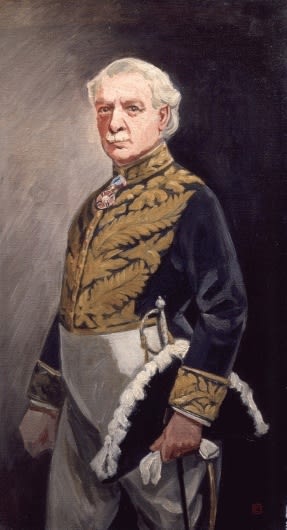
Sir James Guthrie RA, PRSA, HRHA
Portrait Sketch of David Lloyd George (1863-1945), 1919
Oil on canvas
21 x 12 in. (53.5 x 30.5 cm)
Inscribed on reverse: ''Lloyd George Sir James Guthrie R.S.A''"
Philip Mould & Co.
To view all current artworks for sale visit philipmould.com Sir James Guthrie was born at Greenock on 10th June 1859. He studied with John Pettie in London in 1879...
To view all current artworks for sale visit philipmould.com
Sir James Guthrie was born at Greenock on 10th June 1859. He studied with John Pettie in London in 1879 before returning to Scotland in 1882, working in Glasgow from 1887-97, and settling in Edinburgh where he was elected P.R.S.A from 1902 until 1919. During the final year of his Presidency, Guthrie was commissioned to paint ''Some Statesmen of the Great War'' for the National Portrait Gallery, a job that required enormous time and effort (the finished canvas stands thirteen feet high and incorporates seventeen full scale figures). He was briefed to the effect that he could paint the Statesmen in ''…any clothes the artist wished but no hats to be worn, and any arrangement the artist thought suitable''(1).
Although it is likely that he came to a fixed composition at an early stage, (many of the studies are painted in the same poses and lighting as in the finished work), it is entirely possible that this sketch constitutes an initial idea for that great painting. Frances Stevenson (Lloyd George's assistant) writes in her diary for the 29th of November 1919 that, ''Sir James Guthrie has painted a wonderful likeness of D(avid). He had the last sitting this morning. Mrs. Ll.G. went up to look at it, & when D. asked her what she thought of it she said - ''I can't lay my finger on anything bad in it!''(2). This likely refers to Guthrie's study of Lloyd George seated in a suit and tie, as he is positioned in the completed work, that is on display in the Scottish National Portrait Gallery. However, given that ''…in several cases, more than one study was done of the sitter''(3), it is certainly possible that the artist experimented previously with the Court dress in which the Statesman is portrayed in this sketch... Furthermore, Guthrie went on to paint Sir John Gilmour, BT., M.P. in similar dress; the frocking of his tunic, medal and hat closely matching those worn by Lloyd George, and it would be entirely feasible to envisage this completed portrait as the culmination of earlier experimentation with our sitter.
1) Sir. J. Cow, Sir James Guthrie, 1932.
2) Ed. A.J.P. Taylor, Lloyd George - A Diary by Frances Stevenson, 1971, pg.190.
3) Cow, Sir James Guthrie.
Sir James Guthrie was born at Greenock on 10th June 1859. He studied with John Pettie in London in 1879 before returning to Scotland in 1882, working in Glasgow from 1887-97, and settling in Edinburgh where he was elected P.R.S.A from 1902 until 1919. During the final year of his Presidency, Guthrie was commissioned to paint ''Some Statesmen of the Great War'' for the National Portrait Gallery, a job that required enormous time and effort (the finished canvas stands thirteen feet high and incorporates seventeen full scale figures). He was briefed to the effect that he could paint the Statesmen in ''…any clothes the artist wished but no hats to be worn, and any arrangement the artist thought suitable''(1).
Although it is likely that he came to a fixed composition at an early stage, (many of the studies are painted in the same poses and lighting as in the finished work), it is entirely possible that this sketch constitutes an initial idea for that great painting. Frances Stevenson (Lloyd George's assistant) writes in her diary for the 29th of November 1919 that, ''Sir James Guthrie has painted a wonderful likeness of D(avid). He had the last sitting this morning. Mrs. Ll.G. went up to look at it, & when D. asked her what she thought of it she said - ''I can't lay my finger on anything bad in it!''(2). This likely refers to Guthrie's study of Lloyd George seated in a suit and tie, as he is positioned in the completed work, that is on display in the Scottish National Portrait Gallery. However, given that ''…in several cases, more than one study was done of the sitter''(3), it is certainly possible that the artist experimented previously with the Court dress in which the Statesman is portrayed in this sketch... Furthermore, Guthrie went on to paint Sir John Gilmour, BT., M.P. in similar dress; the frocking of his tunic, medal and hat closely matching those worn by Lloyd George, and it would be entirely feasible to envisage this completed portrait as the culmination of earlier experimentation with our sitter.
1) Sir. J. Cow, Sir James Guthrie, 1932.
2) Ed. A.J.P. Taylor, Lloyd George - A Diary by Frances Stevenson, 1971, pg.190.
3) Cow, Sir James Guthrie.
Exhibitions
Brighton Arts ClubBe the first to hear about our available artworks
* denotes required fields
We will process the personal data you have supplied in accordance with our privacy policy (available on request). You can unsubscribe or change your preferences at any time by clicking the link in our emails.